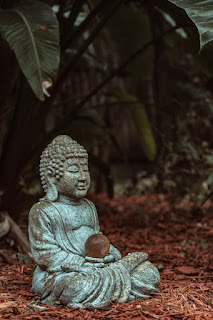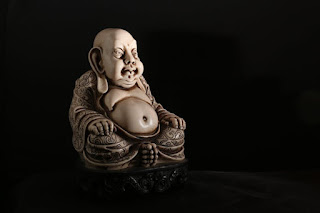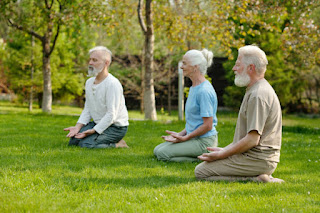Choosing Your Meditation Style: A Comparative Look
Meditation has woven its way through the tapestry of human culture for centuries, serving as a cornerstone in the quest for peace, clarity, and enlightenment. Originating from ancient traditions, meditation today is recognized not just as a spiritual practice but as a powerful tool for enhancing mental health, managing stress, and improving overall well-being. As it gains prominence in the realms of health and wellness, the practice of meditation has evolved and diversified, offering a plethora of styles to suit various preferences and goals.
At its core, meditation is the practice of turning one’s attention to a single point of reference. It can involve focusing on the breath, on bodily sensations, or on a word or phrase known as a mantra. In essence, meditation helps the mind to become more aware of itself and the surrounding world, promoting a state of mindfulness that carries through all aspects of life.

However, the journey to finding the most compatible meditation style is deeply personal and can be influenced by one’s lifestyle, personal preferences, and the specific benefits one hopes to gain from the practice. Whether seeking to reduce stress, find inner peace, enhance concentration, or embark on a spiritual journey, there is a meditation practice designed to meet those needs. From the structured approach of Transcendental Meditation to the flexibility of Mindfulness and the disciplined simplicity of Zen, the options are as varied as the individuals seeking serenity through their practice.
In this comparative look at meditation styles, we aim to illuminate the distinct paths available, offering insights into each method’s principles, practices, and benefits. Our goal is to provide a comprehensive guide that assists you in navigating the expansive world of meditation, empowering you to choose a style that resonates with your personal journey towards mindfulness and well-being.

Mindfulness Meditation: Presence and Awareness
In the bustling rhythm of modern life, where distractions are omnipresent, mindfulness meditation emerges as a beacon of tranquility and presence. Rooted in ancient Buddhist teachings, mindfulness meditation is a practice that encourages acute awareness of the present moment. It teaches practitioners to observe their thoughts, feelings, and sensations without judgment, fostering a state of openness and curiosity towards their inner and outer experiences.
The Practice of Mindfulness Meditation
Mindfulness meditation begins with the breath. Practitioners find a comfortable, seated position and focus their attention on their breathing—on the inhalation and exhalation. This practice might seem simple, yet it serves as the foundation for a profound transformation in awareness. When the mind wanders, as it naturally will, the meditator gently redirects their focus back to their breath. This act of returning to the breath strengthens the mind’s ability to maintain focus, cultivates patience, and promotes a deep sense of inner peace.
Benefits of Mindfulness Meditation
The benefits of mindfulness meditation are extensive and well-documented. Regular practice has been shown to reduce stress, anxiety, and depression. It enhances emotional regulation, leading to better mood and behavior control. Additionally, mindfulness meditation improves focus, concentration, and cognitive flexibility, making it easier to adapt to changing circumstances.
Practicing mindfulness can also enhance physical health by lowering blood pressure, reducing chronic pain, and improving sleep. It creates a sense of balance that radiates through all aspects of an individual’s life, offering a tool for dealing with the challenges and stresses of daily life.
Tips for Beginners
For those new to mindfulness meditation, starting with short, daily sessions can make the practice more approachable. Even five minutes a day can make a significant difference in fostering mindfulness. There are numerous resources available for beginners, including guided meditations and apps designed to introduce the fundamentals of the practice.
One of the most important tips for beginners is to approach meditation with patience and without expectation. Mindfulness is a skill that develops over time, and its benefits are cumulative. By consistently dedicating time to practice, beginners can cultivate a deeper sense of awareness and presence that extends beyond the meditation session into every aspect of their lives.

Transcendental Meditation: Beyond the Conscious Mind
Transcendental Meditation (TM) offers a distinctive approach to meditation, providing a pathway to explore the depths of consciousness and achieve a state of deep rest unlike any other. Originating from the Vedic tradition of India, TM has gained global recognition for its simplicity and effectiveness. It involves the silent repetition of a mantra, a sound without meaning, which serves as a vehicle to settle the mind and transcend ordinary thought, reaching a state of pure consciousness.
The Technique and Its Unique Approach
The practice of TM is unique in that it requires no concentration, no control of the mind, no contemplation of thoughts or images. It is a simple, natural, and effortless technique practiced for 20 minutes twice a day while sitting comfortably with the eyes closed. The mantra, given by a certified TM teacher, is used not as an object of focus but as a subtle sound that leads the awareness inward, beyond thought, to experience the source of thought itself.
Scientifically Backed Benefits
The benefits of Transcendental Meditation are extensive and have been validated by over 600 scientific studies. These studies have shown that TM can reduce stress and anxiety, improve heart health, and enhance brain function and memory. It is also associated with increased creativity, higher levels of energy, and improved emotional well-being. Notably, the practice has been found to lower cortisol levels, the stress hormone, thereby promoting a state of relaxation and reduced stress.
One of the most significant benefits reported by TM practitioners is the experience of inner peace and calm, even in the midst of dynamic activity. This sense of serenity is attributed to the deep state of restful alertness achieved during meditation.
Getting Started with Transcendental Meditation
To begin practicing TM, it is recommended to learn from a certified TM teacher. The instruction ensures that each practitioner receives a personalized mantra and understands the technique’s subtleties. The course typically involves personal instruction followed by group practice, providing a comprehensive foundation for integrating the practice into one’s daily routine.
The investment in learning TM pays dividends in the form of improved health, well-being, and quality of life. While the practice requires a specific course for learning, the benefits it offers make it a worthwhile exploration for those seeking deep relaxation and expanded consciousness.

Zen Meditation (Zazen): Simplicity and Discipline
Zen meditation, or Zazen, is a practice deeply rooted in Buddhist philosophy, emphasizing the importance of sitting meditation and the insight it brings into the nature of existence. Zazen is not merely a practice but a manifestation of Zen itself, embodying simplicity, discipline, and a direct encounter with one’s own nature.
The Essence of Zazen
The essence of Zazen lies in its simplicity. It is practiced by sitting in a quiet place, maintaining upright posture, and focusing on one’s breath. The eyes are kept open to avoid drowsiness, and the breath is allowed to flow naturally. This process aligns the mind, body, and breath, facilitating a deep state of concentration and awareness.
Unlike other meditation practices that may use mantras or guided visualization, Zazen emphasizes “just sitting.” This means letting thoughts, feelings, and images pass without getting entangled in them. The practice encourages a non-dualistic view of mind and body, where one is fully present and aware without attachment or aversion to particular thoughts or sensations.
Benefits and Challenges
Practicing Zazen can lead to profound mental clarity, emotional stability, and increased insight into the nature of the self and reality. It cultivates a sense of peace and equanimity, helping practitioners navigate the challenges of life with greater calmness and less reactivity.
However, the simplicity of Zazen is also its challenge. The discipline required to “just sit” without attachment to thoughts or outcomes can be difficult for beginners. It is a practice that requires patience, as the benefits accrue over time with consistent practice.
Practical Tips for Starting Zazen
For those interested in beginning Zazen, it is helpful to start with short periods of meditation, gradually increasing the time as comfort with the practice grows. Finding a quiet space where one can sit undisturbed is crucial, as is maintaining a regular schedule to cultivate discipline.
Many find it beneficial to join a Zen group or seek instruction from a qualified teacher, as this provides support and guidance on the subtleties of the practice. While Zazen can be practiced alone, the community aspect of Zen practice can be invaluable, offering encouragement and shared insights.

Guided Meditation: The Role of Guided Imagery and Visualization
Guided meditation is a versatile and accessible form of meditation that has gained popularity for its ease of use and the wide range of benefits it offers. It involves following a meditation session led by a guide, which can be in person, through an audio recording, or even a video. The guide directs the listener’s imagination towards a state of relaxation, healing, or achieving specific objectives, using descriptive language, storytelling, and sometimes music or sound effects.
Exploring the Depths of Guided Meditation
The essence of guided meditation lies in its ability to utilize the power of the mind’s imagery. Through guided imagery and visualization, participants are led on a journey that can profoundly impact their emotional, physical, and mental state. This journey can lead to places of unparalleled tranquility, provide insights into personal dilemmas, or instill a deep sense of confidence and motivation.
Benefits Across the Spectrum
Guided meditation is particularly effective for those new to meditation or those who find it challenging to concentrate or silence their thoughts. It offers a plethora of benefits, including stress reduction, improved emotional health, enhanced self-awareness, and better sleep. For individuals dealing with health issues, guided imagery can be a powerful tool for pain management and recovery, as it encourages the body and mind to work together towards healing.
Moreover, guided meditation can be tailored to specific goals, such as improving self-esteem, overcoming fears, or enhancing performance in various aspects of life. This customizability makes it a valuable resource for personal development and growth.
Finding Your Guided Path
With the abundance of guided meditations available, finding sessions that align with your needs and preferences is key. Many apps, websites, and social media platforms offer guided meditations on a variety of topics. When selecting a guided meditation, consider the voice of the guide, the length of the session, and the specific focus or goal of the meditation to ensure it aligns with what you’re seeking.
For those interested in exploring guided meditation, starting with a few different styles and guides is a good approach. This allows you to discover what resonates best with you and what effectively aids you in achieving a meditative state or your desired outcomes.

Vipassana Meditation: The Art of Seeing Clearly
Vipassana Meditation, which means “to see things as they really are,” is one of India’s most ancient techniques of meditation. Rediscovered by Gotama Buddha more than 2500 years ago, it has a simple, profound premise: the systematic observation of reality, primarily through the lens of bodily sensations, to purify the mind of impurities such as hatred, greed, and delusion, leading to a state of liberation and enlightenment.
Principles and Practice
The practice of Vipassana is straightforward yet deeply transformative. It requires practitioners to observe their physical sensations meticulously, whether pain, warmth, tingling, or anything else, without attaching meaning or reaction to them. This practice helps meditators understand the impermanent nature of these sensations and, by extension, all experiences and emotions, fostering a sense of detachment and equanimity.
Vipassana is often taught in 10-day residential courses, where participants observe noble silence and meditate for several hours each day. This immersive experience is designed to jumpstart the practitioner’s journey into Vipassana, offering a comprehensive introduction to the technique’s principles and practices.
Benefits of Vipassana Meditation
The benefits of regular Vipassana practice are profound. Practitioners report enhanced mindfulness and presence, increased emotional intelligence, and a greater sense of inner peace. The technique’s emphasis on experiential wisdom helps individuals develop deeper insights into the nature of suffering and happiness, leading to more compassionate and balanced living.
Moreover, Vipassana meditation has been linked to reduced stress, anxiety, and depression, improved mental clarity and focus, and better physical health outcomes, including lower blood pressure and improved sleep patterns.
Starting Your Vipassana Journey
For those interested in exploring Vipassana, the recommendation is to start with a 10-day course offered by one of the many centers worldwide. These courses are usually offered on a donation basis, making them accessible to everyone. Post-course, maintaining a daily practice is crucial for integrating the insights and benefits of Vipassana into everyday life.
Vipassana is a journey of self-discovery and liberation. While it requires dedication and discipline, the clarity and peace it brings to the mind and heart are immeasurable, offering a path toward a more mindful and enlightened existence.

Loving-Kindness Meditation (Metta): Cultivating Compassion
Loving-Kindness Meditation, or Metta Bhavana, is a practice rooted in the Buddhist tradition, aimed at developing unconditional love and compassion for oneself and others. Unlike meditations that focus on breath or physical sensations, Metta emphasizes the cultivation of positive emotions and attitudes, fostering a spirit of goodwill, kindness, and warmth towards all beings without discrimination.
The Practice of Metta Meditation
The practice typically begins with the meditator focusing on themselves, silently repeating phrases like “May I be happy, may I be healthy, may I be safe, may I live with ease,” before progressively extending these wishes to loved ones, acquaintances, strangers, and even those with whom one may have conflicts. This expansion of benevolence helps to dissolve barriers of resentment, anger, and negativity, paving the way for a heart filled with compassion and kindness.
Benefits of Loving-Kindness Meditation
Engaging in Loving-Kindness Meditation has numerous benefits. Practitioners often experience a significant increase in positive emotions, leading to improvements in personal well-being, increased empathy, and reduced feelings of social isolation. Metta meditation has also been shown to decrease symptoms of anxiety and depression, enhance emotional intelligence, and even improve overall physical health by reducing stress levels and promoting relaxation.
Incorporating Metta into Daily Life
Starting with just a few minutes a day, anyone can incorporate Metta meditation into their routine. It can be particularly powerful when facing personal difficulties or conflicts, serving as a reminder of our shared humanity and the universal desire for happiness and peace. Over time, this practice can transform the way one interacts with themselves and the world, promoting a more compassionate and understanding approach to life’s challenges.
Loving-Kindness Meditation encourages us to look beyond our immediate concerns and connect with a more profound sense of shared experience and universal love. It is a journey towards opening the heart, fostering a community of kindness, and ultimately, experiencing a deeper, more fulfilling connection with life itself.

Yoga Meditation: Unity of Mind and Body
Yoga Meditation extends beyond the physical postures (asanas) commonly associated with yoga, delving into practices that unite the mind, body, and spirit. It encompasses a broad range of techniques, including breath control (pranayama), concentration (dharana), and meditation (dhyana), aimed at achieving inner peace and spiritual enlightenment.
Integrating Meditation into Yoga Practice
The essence of Yoga Meditation lies in its holistic approach. It starts with the asanas, which prepare the body for longer periods of sitting in meditation. Pranayama techniques follow, which control the breath to calm the mind and regulate energy flow through the body. Finally, dharana leads the practitioner into dhyana, a state of deep meditation where the mind becomes still and focused, fostering a profound connection with the self and the universe.
The Benefits of Yoga Meditation
Yoga Meditation offers extensive physical, mental, and spiritual benefits. Physically, it improves flexibility, strength, and balance. Mentally, it reduces stress, anxiety, and depression, enhancing overall emotional well-being. Spiritually, it leads to greater self-awareness, a sense of inner peace, and connection to a higher purpose.
The practice of Yoga Meditation can be profoundly transformative, encouraging a mindful approach to daily life and fostering a deeper appreciation for the present moment. It supports a journey of self-discovery, helping individuals to find harmony within themselves and with the world around them.
Starting Your Practice
For beginners, joining a yoga class that emphasizes meditation can provide a solid foundation in these practices. Many yoga studios and community centers offer classes specifically focused on meditation, where one can learn from experienced instructors. Additionally, numerous online resources and apps can guide beginners through the basics of yoga meditation at home.
Incorporating yoga meditation into your routine doesn’t require hours of practice each day; even a few minutes can make a significant difference in your overall well-being. Over time, as you deepen your practice, you may find that the unity of mind and body achieved through yoga meditation becomes an invaluable part of your life.

Qigong and Tai Chi: Harmonizing Body, Mind, and Spirit
Qigong and Tai Chi are ancient Chinese practices that blend meditation, controlled breathing, and gentle movements to promote balance, healing, and spiritual well-being. Rooted in Taoist and Buddhist philosophies, these practices are designed to enhance the flow of qi (vital energy) through the body, achieving harmony between the physical body and the mind.
Understanding Qigong and Tai Chi
Qigong, which translates to “life energy cultivation,” is a holistic system of coordinated body posture, movement, and meditation used for health, spirituality, and martial arts training. Tai Chi, a form of Qigong known for its slow, graceful movements, is often described as “meditation in motion.” Despite their differences, both practices share the common goal of enhancing the practitioner’s overall well-being through the integration of body, mind, and spirit.
The Benefits of Qigong and Tai Chi
The gentle, rhythmic movements of Qigong and Tai Chi improve physical balance, flexibility, and strength, making them particularly beneficial for the elderly or those recovering from injuries. The meditative aspect of these practices reduces stress and anxiety, improves concentration, and promotes a deeper sense of inner peace.
Regular practice of Qigong or Tai Chi has been linked to numerous health benefits, including improved cardiovascular, respiratory, and immune system functions. Additionally, these practices have been shown to aid in reducing hypertension, alleviating symptoms of chronic pain, and enhancing overall mental health.
Getting Started with Qigong and Tai Chi
Starting Qigong or Tai Chi is accessible to people of all ages and fitness levels. Many community centers, gyms, and wellness studios offer classes led by experienced instructors who can provide guidance tailored to individual needs and capabilities. There are also ample resources available online, including instructional videos and guided practices, allowing beginners to explore these exercises at their own pace.
Incorporating Qigong or Tai Chi into your daily routine can serve as a powerful tool for cultivating health, vitality, and tranquility. Even a few minutes each day can contribute to a more balanced and harmonious life, offering a refuge of calm in the fast-paced modern world.

Chakra Meditation: Balancing the Energy Centers
Chakra Meditation is a form of meditation aimed at cleansing and balancing the chakras — the energy centers of the body. According to ancient Indian philosophy, the human body comprises seven main chakras located along the spine, from the base to the crown of the head. Each chakra is associated with different aspects of physical, emotional, and spiritual well-being. Chakra Meditation seeks to enhance life force energy, or “Prana,” promoting harmony, health, and consciousness.
The Seven Chakras and Their Significance
- Root Chakra (Muladhara): Located at the base of the spine, it represents stability, survival, and grounding.
- Sacral Chakra (Svadhisthana): Situated in the lower abdomen, it governs creativity, pleasure, and emotional body.
- Solar Plexus Chakra (Manipura): Found in the stomach area, it symbolizes personal power, confidence, and self-control.
- Heart Chakra (Anahata): Positioned at the heart, it embodies love, compassion, and acceptance.
- Throat Chakra (Vishuddha): Located at the throat, it represents communication, expression, and truth.
- Third Eye Chakra (Ajna): Found in the forehead, between the eyes, it symbolizes intuition, insight, and mental clarity.
- Crown Chakra (Sahasrara): Situated at the top of the head, it represents spiritual connection and enlightenment.
Practices and Benefits of Chakra Meditation
Chakra Meditation involves focusing on each chakra, using specific mantras, colors, and visualization techniques to unlock and balance each energy center. This process can release blockages, leading to improved energy flow throughout the body and promoting physical, emotional, and spiritual healing.
Regular practice of Chakra Meditation can enhance one’s ability to remain calm, grounded, and present. It fosters a deeper understanding of oneself, boosts creativity, and promotes a sense of inner peace and connection to the universe. Additionally, it can aid in resolving past traumas, improving relationships, and advancing on one’s spiritual path.
Starting Your Practice
For beginners, guided Chakra Meditation sessions can be a helpful way to familiarize oneself with the chakras and their corresponding meditation techniques. Many online resources, apps, and books provide detailed guidance on how to engage in Chakra Meditation effectively.
Incorporating Chakra Meditation into your routine requires patience and practice. As you become more attuned to the energy flow within your body, you may begin to notice profound shifts in your perception, well-being, and overall quality of life.

Choosing Your Path: Factors to Consider and Finding Your Fit
The journey into meditation is deeply personal and varies from one individual to another. With the plethora of meditation styles available, finding the one that resonates with you can be a transformative step towards greater peace, understanding, and well-being. Here are some considerations and tips to help you navigate the vast landscape of meditation practices and choose the path that best suits you.
Assess Your Goals and Needs
Begin by reflecting on what you hope to achieve through meditation. Are you seeking stress relief, enhanced concentration, spiritual growth, or emotional healing? Different meditation practices offer distinct benefits and may be more suited to specific goals. For instance, mindfulness meditation is renowned for its stress-reducing effects, while loving-kindness meditation can foster greater empathy and positive emotions.
Consider Your Lifestyle
Your daily routine and lifestyle can also influence your choice of meditation. Busy individuals may find short, guided meditations more accessible, while those with more flexibility might be drawn to longer, more structured practices like Zen or Transcendental Meditation. Consider how a meditation practice can best fit into your life without becoming an additional source of stress.
Explore Different Practices
Don’t hesitate to explore various meditation styles. Many meditation centers and online platforms offer introductory sessions or courses that can give you a taste of different practices. Experimenting with multiple forms of meditation can provide valuable insights into what feels most natural and beneficial for you.
Listen to Your Intuition
Ultimately, the most suitable meditation style is one that feels right for you. Pay attention to how you feel during and after practice. A suitable meditation technique should leave you feeling refreshed, centered, and at peace. Trust your intuition to guide you towards the practice that best supports your journey.
Seek Community and Support
Engaging with a community of like-minded individuals or finding a mentor can significantly enhance your meditation practice. Communities provide motivation, inspiration, and valuable insights from shared experiences. Whether online or in-person, connecting with others can enrich your meditation journey and provide encouragement during challenging times.
Be Patient and Open-Minded
Finally, approach your exploration of meditation with patience and an open mind. The benefits of meditation often unfold gradually, and your preferences may evolve as you deepen your practice. Remember that the goal of meditation is not perfection but progress towards greater self-awareness, peace, and well-being.
Embarking on Your Meditation Journey: A Path to Inner Peace
In navigating the diverse landscape of meditation practices, from the focused stillness of Mindfulness and Zen to the flowing movements of Qigong and Tai Chi, we’ve uncovered a world rich in spiritual depth and mental clarity. Each style, with its unique approach to fostering inner peace and enhancing self-awareness, invites us to explore the boundless potential of the human spirit. Whether through the silent repetition of a mantra in Transcendental Meditation, the compassionate intentions of Loving-Kindness, or the energetic balance sought in Chakra Meditation, we are offered myriad paths to tranquility and enlightenment.
Choosing a meditation style is not about adhering strictly to one path; it’s about finding a practice that resonates with your heart and spirit. It’s about embracing a practice that brings you closer to the essence of who you are and who you aspire to be. As we’ve seen, meditation transcends cultural and religious boundaries, serving as a universal quest for peace, understanding, and connection.
Final Thoughts: The Journey Ahead
As you stand at the crossroads of this meditative journey, remember that the true essence of meditation lies in the experience — the personal transformation that occurs as you delve deeper into the practice. Be open to experimentation, allowing yourself to be guided by intuition and curiosity. The path to finding your ideal meditation style is a journey of discovery, one that unfolds uniquely for each individual.
Incorporate meditation into your life as a practice of self-love and self-exploration. Allow it to be a sanctuary where you can retreat from the chaos of the external world, to find peace, clarity, and renewal within. The benefits of meditation extend far beyond the moments of practice; they ripple out into every facet of your life, enriching your experiences and interactions with a profound sense of mindfulness and serenity.
As we conclude this guide, may your meditation journey be filled with insightful moments, deep peace, and transformative experiences. Remember, the most profound journey is not outward, but inward, to the very core of your being. May you find joy in the journey and the path that calls to your heart.





